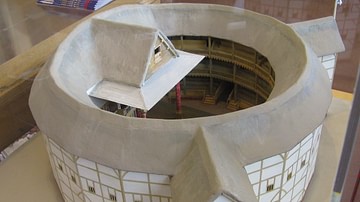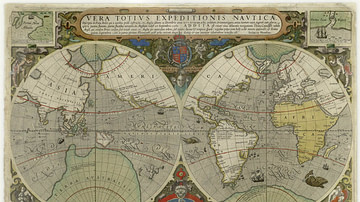
John Fletcher (1579-1625) was a playwright of the English Renaissance who flourished during the Jacobean Era (1603-1625). The author of over 50 plays, he is known for developing the genre of tragicomedy in English literature, and for his collaborations with playwright Francis Beaumont (1585-1616) – together, Fletcher and Beaumont wrote some of the most important tragicomedies of the era including Philaster (circa 1609), The Maid's Tragedy (1609), and A King and No King (1611). It is now generally accepted that Fletcher worked closely with William Shakespeare (1564-1616) in the last year of his career, co-writing Shakespeare's plays Henry VIII, The Two Noble Kinsmen, and the now lost Cardenio. Fletcher, whose popularity rivaled Shakespeare's at the peak of his career, took over as the house playwright for Shakespeare's acting company, the King's Men, and continued in that capacity until his death from the plague in August 1625.
Early Life
John Fletcher was born in the town of Rye in Sussex, England, sometime in December 1579 and was baptized on 20 December. His father, Richard Fletcher, was an Anglican clergyman known to be a "tough-minded preacher, militant in faith" (Wells, 196). As the Dean of Peterborough Cathedral, the elder Fletcher was closely involved with the trial and execution of the Catholic Mary, Queen of Scots, in February 1587; on the scaffold, he entreated the condemned queen to return to Protestantism and prayed for her soul with such vigor that it seemed he was "determined to force his way into the pages of history" (Fraser, 584). A few days later, when Queen Elizabeth I of England (r. 1558-1603) expressed remorse over the execution, Dean Fletcher chided her for her doubts and called for her to go even further in the persecution of her Catholic enemies. With the patronage of the powerful Robert Devereux, Earl of Essex (1565-1601), he became Bishop of London in 1595, a position he held until his death on the evening of 15 June 1596 – smoking a pipe of tobacco in his Chelsea home, Bishop Fletcher apparently turned to a servant and sternly said, "Boy, I die," before dropping dead on the spot (Wells, 196).
Following the bishop's death, John Fletcher and his seven siblings were sent to live with their uncle Giles, a poet and minor diplomat at the queen's court. Giles Fletcher was also connected to the Earl of Essex but lost much of his influence at court after Essex's failed rebellion and ultimate execution in 1601. In the meantime, John was being educated as a dramatist; in 1591, at the age of eleven, he enrolled at Corpus Christi College at Cambridge and, two years later, had become a Bible clerk. Nothing is known of his life between then and the publication of his first play in 1607, but it is likely that he was encouraged by his uncle Giles and cousin Phineas, both poets, to pursue a literary career. Fletcher's first play, The Woman Hater, or the Hungry Courtier, was written in 1606 for the Children of Paul's, a company of boy actors who performed the play once and disbanded shortly afterwards (boy acting troupes had been very popular in Elizabethan theatre). The play was not written alone, but in collaboration with Francis Beaumont, with whom Fletcher would form a productive partnership and a close friendship.
Collaboration with Beaumont
Fletcher and Beaumont had probably met several years before their first known collaboration and may have been working together as early as 1605. A few years younger than Fletcher, Beaumont had initially trained to become a lawyer before abandoning his legal ambitions in favor of a literary career; before long, Beaumont had become the pupil of the noted poet-playwright Ben Jonson (1572-1637) and had single-handedly written his first play, The Knight of the Burning Pestle, by the time he was 22. Both Beaumont and Fletcher contributed verses to the prefix of Jonson's play Volpone (1607), by which time they had begun to collaborate in earnest. Their first work, The Woman Hater, or the Hungry Courtier, is a comedy set in Milan. The main plot is driven by the misogynistic Gondarino – the titular 'woman hater' – who imprisons the heroine Oriana in a brothel, only for her to rescue herself by proving her virtue and marrying the duke. The subplot follows Lazarello – the titular 'hungry courtier' – who spends the play on the hunt for the head of an umbrannes fish, described as a 'sacred dish'. In this work, Fletcher and Beaumont make several references to Shakespeare, which their audience would have recognized and been amused by. In one scene, Count Valore tells Lazarello that the fish head is gone in words borrowed from the Ghost in Hamlet:
VALORE: Hear me with patience.
LAZARELLO: Let me not fall from myself! Speak! I am bound to hear!
VALORE: So art thou to revenge, when thou shalt hear. The fish head is gone, and we know not wither.
(2.1.343-8; Italics by Stanley Wells to emphasize the quotes from Hamlet).
Fletcher and Beaumont went on to collaborate on tragedies including Cupid's Revenge (circa 1607), Philaster (circa 1609), and The Maid's Tragedy (1609). Although Beaumont wrote most of The Maid's Tragedy – indeed, it is thought that Fletcher contributed a mere four scenes – the play is quite characteristic of the pair's joint work, which, according to scholar Stanley Wells, relies on "sudden reversals and unexpected revelations" (206). The play opens with the King of Rhodes forcing his friend Amintor to break off his betrothal to his love, Aspatia, and to marry Evadne instead. It is later revealed that Evadne had been the King's mistress, and the King had forced her to marry Amintor to cover up his own dishonor. Evadne, overcome with guilt, kills the King by tying his arms to his bed and stabbing him to death. Aspatia, meanwhile, has slipped into a depression; disguising herself as a soldier, she provokes a duel with Amintor in the hope that she will die on his sword as a martyr to love. She is mortally wounded in the duel, leaving both Evadne and Amintor to commit suicide. Though the play has often been criticized, it remains notable for the originality of its plot in an era of adaptations, as well as for revitalizing the tired 'revenge tragedy' genre by adding more romance.
Fletcher and Beaumont followed The Maid's Tragedy with a tragicomedy, A King and No King (1611). In this play, King Arbaces of Iberia falls in love with Panthea, who, he thinks, is his sister. Unable to live with this incestuous lust, he is driven mad and decides to rape her before committing suicide. But before he can carry out this heinous deed, Fletcher and Beaumont introduce their twist – it is discovered that Arbaces and Panthea are not related after all, leaving them free to marry. With this play, Fletcher and Beaumont further distinguished themselves from their contemporaries with their distant setting, a bizarre plot that forces the characters to make extreme choices, and the sacrifice of consistent characterization in favor of more dramatic emotional states (Encyclopedia Britannica). These would all become consistent features in their work. After these successes, Fletcher and Beaumont would continue working together on the comedies The Captain (circa 1612) and The Scornful Lady (1613).
The success of this collaboration was likely helped by the fact that Fletcher and Beaumont were close friends who even lived with one another. Their relationship was described by the writer John Aubrey, who, admittedly, wrote several decades after their deaths, but nevertheless offers an interesting insight into the "dearness of friendship" that existed between the two men. Aubrey writes:
They lived together on the Bankside, not far from the playhouse, both bachelors; lay together; had one wench in the house between them, which they did so admire; the same clothes and cloak etc. between them.
(quoted in Wells, 195).
Aubrey's testimony – that the two men shared a bed and even the same clothes – certainly raises questions about the nature of their relationship that can, alas, never be answered. While Fletcher remained a lifelong bachelor, Beaumont eventually married in 1613 and had two daughters. Beaumont likely moved out of their shared apartment around the same time, effectively ending their collaboration; indeed, Beaumont did not long outlive their partnership, dying on 6 March 1616 at the young age of 32.
Solo Works & Development of the Tragicomedy
Even during his productive and successful period of collaboration with Beaumont, Fletcher sometimes wrote plays on his own. His first solo play was The Faithful Shepherdess (circa 1608), a pastoral tragicomedy that made use of both blank and rhymed verse. The play was unpopular with its Jacobean audience, who did not like its lack of plot or its jarring tone; in his preface to the published edition of the play, Fletcher explains that the audience had expected "a play of country hired shepherds in grey cloaks, with cur-tailed dogs in strings, sometimes laughing together, and sometimes killing one another" (quoted in Wells, 199). Fletcher goes on to defend his work by offering his definition of a 'tragicomedy', one that would characterize the later tragicomedies of the Jacobean Era:
A tragi-comedy is not called so in respect to mirth and killing, but in respect it wants [i.e., lacks] deaths, which is enough to make it no tragedy, yet brings some near it, which is enough to make it no comedy, which must be a representation of familiar people, with such kind of trouble as no life be questioned.
(ibid)
In other words, a Fletcherian tragicomedy has a plot too serious for a comedy but too light-hearted for a tragedy, with a lower-stakes conflict that is usually not life-or-death. The tragicomedies written by Fletcher – or by others in a Fletcherian style – came to have the same hallmarks as his work with Beaumont, such as unexpected plot revelations and far-off settings; Shakespeare's The Tempest (1611) is perhaps one of the most famous examples. Despite the relative failure of his first solo venture, Fletcher continued to write many plays alone, several of which went on to achieve success. The most notable of his solo plays include The Mad Lover (1617), The Loyal Subject (1618), The Humorous Lieutenant (1619), Woman Pleas'd (circa 1620), Island Princess (circa 1620), and A Wife for a Month (1624) – all of these are tragicomedies, conforming more or less to Fletcher's own definition.
Collaborations with Shakespeare & the King's Men
Fletcher's earliest association with the works of Shakespeare came in 1611, when he penned a comedy entitled The Woman's Prize, or the Tamer Tamed. The play was written as a counterpart to Shakespeare's early work The Taming of the Shrew, written about 20 years prior. In Shakespeare's comedy the character Petruchio uses psychological tricks to 'tame' the headstrong Kate – the titular shrew – into a docile, obedient wife. Fletcher's play reverses the roles; it is now Petruchio who is 'tamed' by Maria, his second wife, taken after Kate's death. As Stanley Wells observes, the original play seemed to uphold the "orthodox patriarchal view of the place of women in marriage," to which Fletcher's unofficial sequel "plotted a counterblast" (205). Since The Woman's Prize was first performed by the King's Men (the acting company for whom Shakespeare wrote), it is very likely that Shakespeare approved of Fletcher's play. Indeed, in 1633, the King's Men would famously perform The Taming of the Shrew and The Woman's Prize back-to-back before the court of King Charles I of England (r. 1625-1649).
Not long after this, Fletcher would work more directly with Shakespeare, whose output had begun to slow down; by 1611, Shakespeare had already written The Tempest, the last play he would ever write on his own. Scholars do not know why Shakespeare worked only in collaboration in the last year of his career – perhaps he was ill and needed help, as has been speculated, or perhaps he was feeling the effects of age and needed younger collaborators to keep his works relevant. In any case, it appears that Shakespeare first collaborated with Fletcher on the tragicomedy Cardenio (1613). Now lost, the play was probably inspired by an episode from Miguel de Cervantes' work Don Quixote, which had first been translated into English in 1612. Judging from the title, the play likely centered around the character Cardenio, who, in the original text, is driven mad and lives in the Sierra Moreno mountains. Fletcher would go on to draw from Don Quixote in future works.
Next, the pair collaborated on a play originally titled All is True about the reign of King Henry VIII of England (r. 1506-1547); in keeping with the style of Shakespeare's other history plays, it was eventually referred to as simply Henry VIII. Fletcher's stylistic influence on this play can clearly be seen – he is more likely to use the word 'has' rather than 'hath', and 'ye' rather than 'you', words that appear more readily in Henry VIII than in previous Shakespeare works. Moreover, both Fletcher's and Shakespeare's distinct writing styles can be found in this play – as the 19th-century writer Charles Lamb famously describes the differences, Fletcher "lays line upon line, making up one after another, adding image to image so deliberately that we see where they join. Shakespeare mingles everything, embarrasses sentences and metaphors; before one idea has burst its shell, another is hatched and clamours for disclosure" (quoted in Wells, 214). It was at the first performance of Henry VIII that the Globe Theatre caught fire and burned down – luckily, no one was killed. It is believed that Shakespeare and Fletcher collaborated one final time on The Two Noble Kinsmen, the last play that Shakespeare wrote before his retirement to Stratford-upon-Avon.

By 1616 – the year of both Beaumont's and Shakespeare's deaths – it seems that Fletcher had been contracted by the King's Men to be their house playwright, much as Shakespeare had been for the previous two decades. For the remainder of his career, Fletcher wrote only for the King's Men. The plays he wrote during this time were almost all successful and were mostly written with a collaborator; Fletcher initially worked alongside Nathan Field, a former boy actor turned playwright. After Field's death around 1620, Fletcher began working with Philip Massinger, with the pair writing an astounding 17 plays together.
Death
Fletcher continued to work until his death from plague in August 1625. According to John Aubrey, he refused to leave London during a plague outbreak, preferring to stay behind to finish making himself a suit of clothes, which he was doing with the help of a tailor. One day, Fletcher noticed an abscess on his arm and asked the tailor to help him dress it with ivy leaves. While he was doing this, the tailor noticed the tell-tale plague sores on Fletcher's body. The playwright died shortly thereafter, aged 45; as Aubrey puts it, "death stopped his journey and laid him low here" (quoted in Wells, 221). Fletcher left behind a legacy as one of the most important dramatists of the Jacobean Era, whose work with tragicomedies and collaborations with Beaumont and Shakespeare cemented his place in the pantheon of English literature.









